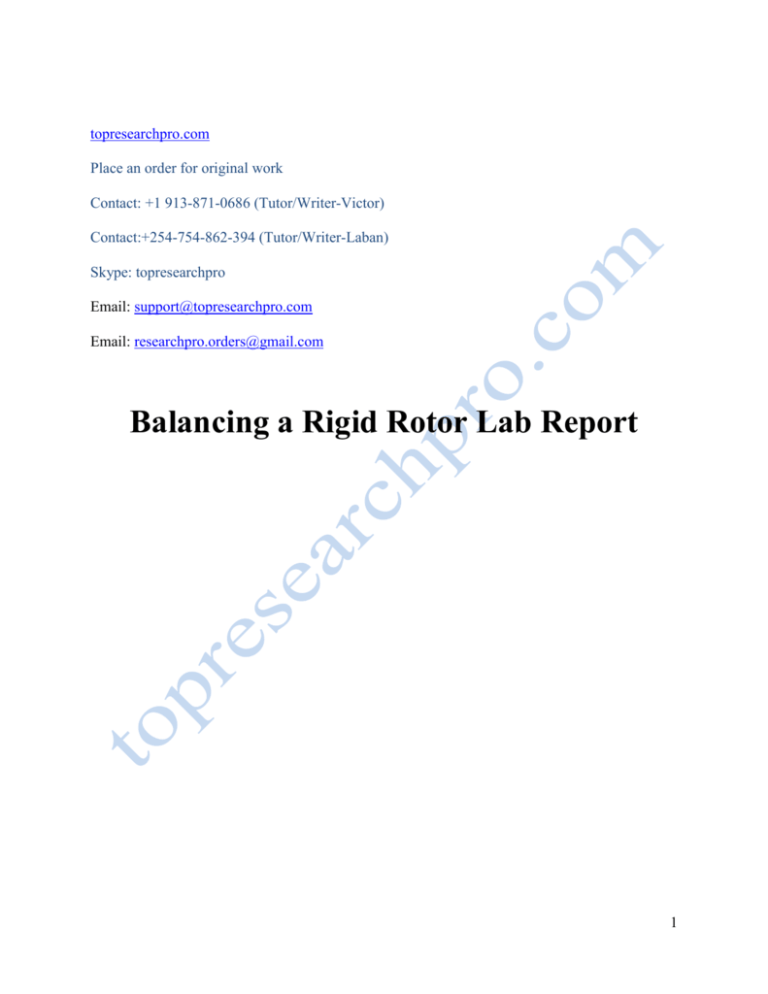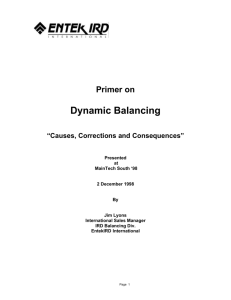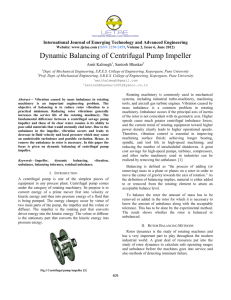Balancing a Rigid Rotor Lab Report
advertisement

topresearchpro.com Place an order for original work Contact: +1 913-871-0686 (Tutor/Writer-Victor) Contact:+254-754-862-394 (Tutor/Writer-Laban) Skype: topresearchpro Email: support@topresearchpro.com Email: researchpro.orders@gmail.com Balancing a Rigid Rotor Lab Report 1 Summary A rigid rotor requires to be evenly positioned about its axis so that it may run true. If the rotor is not properly balanced, it vibrates as speed increases and may cause mechanical damages. One requirement for proper balancing of the rotor is even distribution of rotor mass about the center line for minimal resultant vibration. Some levels of unbalance may be tolerated vary at some certain speed but as speed increases, the unbalance and its effect worsen. To investigate unbalance on a rigid rotor, a laboratory test was done on an unbalanced rigid rotor and both static and dynamic balancing procedures were performed on the rotor. The objective was to apply the theory of rotor balancing, gain skills on rotor balancing and get to know how to operate the Balancing machine. The results were then compared to a theoretical expectation in result analysis. topresearchpro.com Place an order for original work Contact: +1 913-871-0686 (Tutor/Writer-Victor) Contact:+254-754-862-394 (Tutor/Writer-Laban) Skype: topresearchpro Email: support@topresearchpro.com Email: researchpro.orders@gmail.com 2 BALANCING MACHINE INTRODUCTION & THEORY Unbalance may be defined as “uneven distribution of mass about the rotor’s Rotating Center Line RCL” (Bruel, 2000). RCL is the axis the rotor would rotate if not constrained to the bearings. Geometric center line GCL is the physical center line of the rotor. Three types of unbalance can occur. a) Static Unbalance- RCL is displaced parallel to GCL. See Appendix A b) Dynamic Unbalance- RCL and GCL do not intersect and are not parallel. See Appendix B c) Couple Unbalance- RCL and GCL coincide at the center of gravity. See Appendix C The lab test was intent on performing balancing procedures for Static and Dynamic Unbalance. (They are the most common unbalances). Balancing is done by placing an identified mass at a given precise location on the rotor. Test rig description A rigid rotor can be corrected by making corrections in any two planes that can be selected arbitrarily. The test rig schematic is shown in figure 1. BALANCING SET PHASE TACHOMETER ACCELEROMETER ROTOR BEARING BEARING FIGURE 1: TEST RIG SCHEMATIC 3 The balancing set has a vibration meter, vibration analyzer and a phase indicator. Piezoelectric accelerometer and photoelectric tachometer are also connected to the display (Bruel 2000). The rotor was driven by a separately located motor via a belt as shown in figure 2. ROTOR BELT MOTOR PLANE1 PLANE1 PLANE2 BEARING BEARING BEARING PLANE VIEW: DYNAMIC BALANCING (2PLANES) STATIC BALANCING (1PLANE) FIGURE2: RIGID ROTOR BALANCING; DYNAMIC AND STATIC PROCEDURE FOR EXPERIMENT Connection as shown in figure1 was connected followed by a frequency analysis to determine any unbalance. (At the frequency of rotation, an unbalanced rotor has a peak in the vibration level). The initial trial masses for balancing were then estimated. Static Balancing Accelerometer and tachometer were mounted on the rotor as in figure 1 Machine was run at test speed. Vibration level and phase angle were noted. The machine was then stopped and a trial mass was mounted on the chosen correction circle. The new level of vibration and phase angle were noted. 4 The machine was then stopped and the trial mass was removed. The desired values of correction mass and phase were computed. A correction mass was mounted at the very radius that was used for trial mass. The machine was restarted. Residual unbalance was measured. The procedure was repeated until minimal residual unbalance was observed Dynamic balancing Two accelerometers were mounted in the two opposite planes of the rotor depicted in figure2. A tachometer was also mounted and connected to the balancing set as in figure1. The machine was run at test speed and the vibration level and phase angle for each of the planes was noted. The machine was then stopped and a trial mass was mounted. The machine was started again with vibration level and phase for each plane being noted. The machine was stopped again and the trial mass removed. A trial mass was mounted on the second plane and procedure repeated. Correction masses were then mounted just as in static and residual unbalance noted. The criteria used for repeating the procedure was: ΔΦ < 250 ΔΦ > 250 ΔV<25% Increase trial mass Proceed ΔV>25% Move trial mass Proceed Results Record table 1: Calculated tolerance (static balancing; 1 plane only) Radius 49.7 No. of runs Rotor mass 0.693 Unbalance G 2.5 Angle 0.420 0.020 1330 3560 Service speed 3000 rpm Balancing mass 0.4 0.4 Test speed 1993 rpm Balancing angle 5 Calculations 𝑚= 𝑀𝑒 0.693 × 8 = = 0.11𝑔 𝑟 49.7 Record table 2: Calculated tolerance (Dynamic balancing; 2 planes) rotor a mass b P1 0.9285 No. of runs 1 2 3 38.17 25.08 c 10.27 P2 R1 37.5 Unbalance R2 37.5 Unbalance Mag 1.10 1.68 3.33 Mag 1.00 1.52 0.13 Phase 1350 1330 1310 P1 Balancing Mass Mag Phase 1.1 1350 1.6 1330 3.3 1310 Phase 3050 3160 790 Service 3000rpm speed Test 1500rpm speed P2 Balancing Mass Mag 1.0 1.5 0.1 Phase 3050 3150 790 Calculations 𝑚= 𝑀𝑒 0.9285 × 8 0.198 = = 0.198𝑔; = 0.099𝑔 𝑟 37.5 2 Discussion From the above tabulated results, graphs were plotted. Residual unbalance after the balancing procedure was determined from the graphs. Table 1: R=49.7 Graph of Magnitude vs Phase 0.45 0.4 0.35 Magnitude 0.3 0.25 0.2 0.15 0.1 0.05 0 100 150 200 250 300 350 400 Phase (degrees) 6 Table2: P1, Unbalance Table2: P2, Unbalance 3.6 1.6 3.4 1.4 3.2 1.2 Magnitude Magnitude 3 2.8 2.6 2.4 1 0.8 0.6 2.2 0.4 2 0.2 1.8 1.6 131 131.5 132 132.5 133 133.5 134 134.5 0 50 135 100 150 Phase (degrees) 200 250 300 350 Phase (degrees) Table2: P1, Balancing Table2: P2, Balancing 3.5 1.5 Magnitude Magnitude 3 2.5 2 1 0.5 1.5 1 131 131.5 132 132.5 133 133.5 134 134.5 135 Phase (degrees) 0 50 100 150 200 250 300 350 Phase (degrees) In static balancing, a balancing mass of 𝑚 = 0.11𝑔 was determined. From the graph, the magnitude unbalance reduced linearly when the balancing mass was applied. In dynamic balancing, imbalance on plane 1 was eliminated and virtually, residual unbalance Vres≈0. Plane 2 did not exhibit unbalance as seen from the graph. Advantages, disadvantages and inaccuracies Balancing is beneficial because it reduces vibrations and noise. This prevents wear and tear of the bearings and also of the equipment. However, the balancing methods used here may require long time to get the correct masses for rectifying the unbalance. Experimental inaccuracies arise because the rotor is assumed to be perfectly rigid and the bearings free from friction whereas this is not so practically. (Dunn 2008). 7 Other balancing methods There are other methods for rotor balancing that include balancing without using trial weights. One of those methods ‘One shot’ method. In this method machine loading is controlled at transducer locations by using an instrumented force hammer to impact the rotor instead of using trial weights (Cindy, 2006). Since no trial weights are used, the method is faster than dynamic and static balancing techniques. Further, future imbalance on the rotor is permanently rectified using this method. Conclusions From the results obtained, an appreciable level of balance on the rigid rotor was achieved with little residual unbalance left on the rotor. The aim of the lab was thus met. 8 References Bruel, K. 2000. Static and Dynamic Balancing of Rigid Rotors. [Online] Available at <www.bksv.com/doc/17-227.pdf > Accessed 27-oct- 2011 Cindy, M. 2006. One Shot Balancing [Online] Available at <http://www.mhm.assetweb.com/DRKNOW/APLPAPR.NSF/apweb/E90495D9D8A6005E8525 67ED00445C8E?OpenDocument> Accessed 27-oct- 2011 Dunn, J.2008. Balancing of Rotating Bodies., Princeton: Educational Testing Services 9 Appendices COG Appendix A Appendix B Appendix C Static Unbalance Dynamic Unbalance Couple Unbalance Static Centre or rotation r Centre of gravity 10 Dynamic angle a angle b a b Vector resolution V1 V2 V3 V3 –Resultant vector 11








